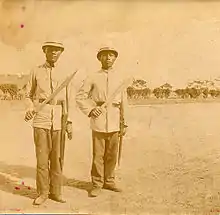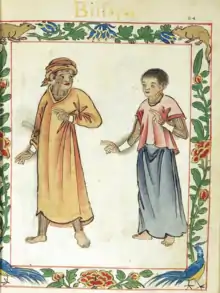Cebuano people
The Cebuano people (Cebuano: Mga Sugbuanon) are the largest subgroup of the larger ethnolinguistic group Visayans, who constitute the largest Filipino ethnolinguistic group in the country. They originated in the province of Cebu in the region of Central Visayas, but then later spread out to other places in the Philippines, such as Siquijor, Bohol, Negros Oriental, southwestern Leyte, western Samar, Masbate, and large parts of Mindanao. It may also refer to the ethnic group who speak the same language as their native tongue in different parts of the archipelago. The term Cebuano also refers to the demonym of permanent residents in Cebu island regardless of ethnicity.
 Cebuano men who served as guards in the early 20th century during the American period. | |
| Total population | |
|---|---|
| 8,683,525 (2020)[1] | |
| Regions with significant populations | |
(Central Visayas, Negros Oriental, Masbate, western parts of Eastern Visayas, large parts of Mindanao) Worldwide | |
| Languages | |
| Cebuano, Filipino, English | |
| Religion | |
| Predominantly Roman Catholicism. Minority others: Aglipayan, Protestantism, Islam, Buddhism, Hinduism, Taoism | |
| Related ethnic groups | |
| Boholano, Ilonggo, Waray, other Visayans other Austronesian peoples |
History

The earliest European record of Cebuanos was by Antonio Pigafetta of the Magellan expedition. He provided some descriptions of their customs as well as samples of the Cebuano language.[2][3] Ferdinand Magellan was killed in Cebu during the Battle of Mactan against the forces of Lapulapu.[4][5]
Later early Spanish colonists referred to the Cebuanos (and other Visayans) as the pintados ("the painted ones"), due to their widespread practice of tattooing to record battle exploits.[5]
Culture and festivities

The majority of Cebuanos are Roman Catholic, with many in rural areas synchronizing Catholicism with indigenous Bisayan folk religion. A minority of Cebuanos (specifically those in Mindanao) are Muslim (due to their contact with the Moro people), or in mixed Chinese-Cebuano families, incorporate Catholic beliefs with aspects of Buddhism or Taoism.[6]
Among the island's notable festivities are the Sinulog[7] festival, which is a mixture of Christian and native cultural elements, celebrated annually every third week of January.
Language
The Cebuano language is spoken by more than twenty million people in the Philippines and is the most widely spoken of the Visayan languages. Most speakers of Cebuano are found in Cebu, Bohol, Siquijor, southeastern Masbate, Biliran, Western and Southern Leyte, eastern Negros and most of Mindanao except Bangsamoro Autonomous Region in Muslim Mindanao.
See also
References
- "Ethnicity in the Philippines (2020 Census of Population and Housing)". Philippine Statistics Authority. Retrieved July 4, 2023.
- Donald F. Lach (1994). Asia in the Making of Europe, Volume I: The Century of Discovery. University of Chicago Press. pp. 175, 635–638. ISBN 9780226467320.
- Sebastian Sta. Cruz Serag (1997). The Remnants of the Great Ilonggo Nation. Rex Bookstore, Inc. p. 95. ISBN 9789712321429.
- Blair, Emma Helen (August 25, 2004). The Philippine Islands. The Project Gutenberg EBook of The Philippine Islands, 1493-1803, Volume II, 1521-1569, by Emma Helen Blair. p. 126, Volume II. [EBook #13280].
- Paul A. Rodell (2002). Culture and Customs of the Philippines. Greenwood Publishing Group. p. 50. ISBN 9780313304156.
- "Culture and Lifestyle". Cebu Province official website. Archived from the original on 2018-08-01. Retrieved 2018-11-13.
- "Cebu Philippines Festivals, Fiestas and Cultural Event". eTravel Pilipinas-Discover the Wonders of Island Paradise. Archived from the original on 2015-09-11. Retrieved 2009-11-18.